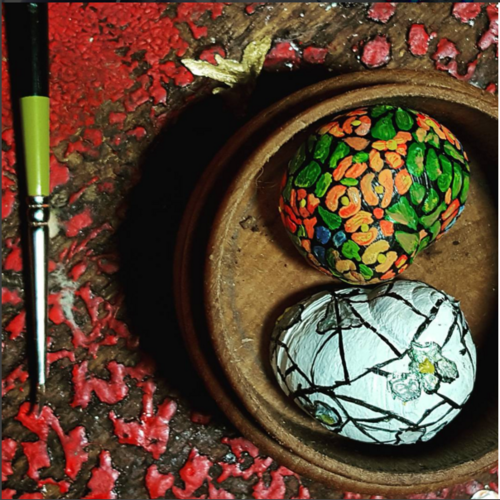Live TifFAUXny Snails Process
Part Two in a creative study of Louis Comfort Tiffany’s work by Kasey Smith.
Poppy Snail by Julia O Test photography
Before the TifFAUXny Snails, my first snail daydreams involved recreating Damien Hirst's Spot Paintings. I wanted to watch color and structure disintegrate, degrade, migrate off the canvas, cease to be legible as Art. It would be a triumph of the organic, base, meandering line over the formal, mechanical grid. And I wanted it to be as large as my disdain for the original source material.
But I struggled to scale this dream, to find enough snails of uniform size to "read" as a proper Hirst. During this period, each one I found therefore became valuable. A thing to seek out. A thing to collect. And in the end, a thing to nurture. As a native Bay Arean I had heard the colloquial wisdom that our garden snails came from France and were escargot snails fallen from their original station. And while gardeners may poison them by the bucketful here, a single live mail order snail still costs between $5 and $8 (before tax and shipping). This snail scarcity and my inability to shop my way out of the situation helped encourage me along new directions. Maybe these snails were better off as singular objects instead of an expansive collection of interchangeable multitudes. Maybe the French were right when their palates placed snails on such a high culinary pedestal? Following this train of thought, maybe they weren't spots after all, maybe they were more like an objet d'art?
And so that is what they became.
Four Seasons Snails
Snails were brought to San Francisco the same year Louis Comfort Tiffany - the prestigious Art Nouveau glass artist - was born in New York. His work - those exquisite objet d’ arts with francophile overtones, contemporaneous to the garden snails’ spread throughout the Bay - would be the inspiration point for a discussion on history, cultural value, cultural change, and worth. But first I had to paint the basics to underpin this discussion.
I started with live snails because while I did not have enough to recreate a Hirst, I did have a small terrarium full of them. The first snails were simple, the brushwork uneven, and were painted in acrylic. Painting on a three-dimensional surface that MOVES proved to be a quite different process from either the Urban Camo Seed Bombs or the FAUXberge Eggs. There were some lessons to be learned.
For instance:
Snails will struggle against you. While their usual response to attack/predation is to pull into their shell, that is not the case when you’re painting them. I can only imagine that being held between the thumb and pointer finger feels like being in the beak of a bird, a lose-lose situation if you freeze instead of fight or flight. Snails, with only a distributed nervous system after all, can’t be expected to know the subtleties between differing kinds of touch/intention.
The snail’s radula, or tongue, is covered in thousands of small chitinous teeth. Aside from helping them eat, they use the radula to clean/maintain the edge of their shell, which means they will continually scrape off the paint unless it’s sealed. Other sources of paint job damage include squeezing into tight spaces, rubbing shells during mating, and just plain old natural growth.
Snails can hibernate for months at a time if conditions aren’t favorable to them. I wrote one snail off as dead, only to discover it was alive three months later. Another time, a snail escaped in the studio and it took me six months to find it alive, hunkered down behind some bins.
Snails are strong, see the first bullet point. If the lid of a terrarium or tank is not properly secured they can push their way out and live for days/weeks eating your books and random paper. Additionally, pushing the tank lid aside is one source of paint job damage.
To date, I have painted 21 live snails, 9 of which were still alive as of summer of 2019. They live about 5 years in captivity and I tend to paint the larger, older snails so on average I I have them for about 9-18 months, maintaining and repainting them as they damage and outgrow their designs. Deceased snails are buried for 4 weeks before being mounted and added to the greater TifFAUXny Snail display.
This greater display contains 9 live snails, 12 deceased snails, and 42 escargot serving shells; all with patterns directly adopted from Tiffany’s work. I also painted an additional 8 escargot serving shells with original designs inspired by Tiffany’s aesthetic. Together they form the visual basis for TifFAUXny Snails - A Tale of Gold and Glass.





















